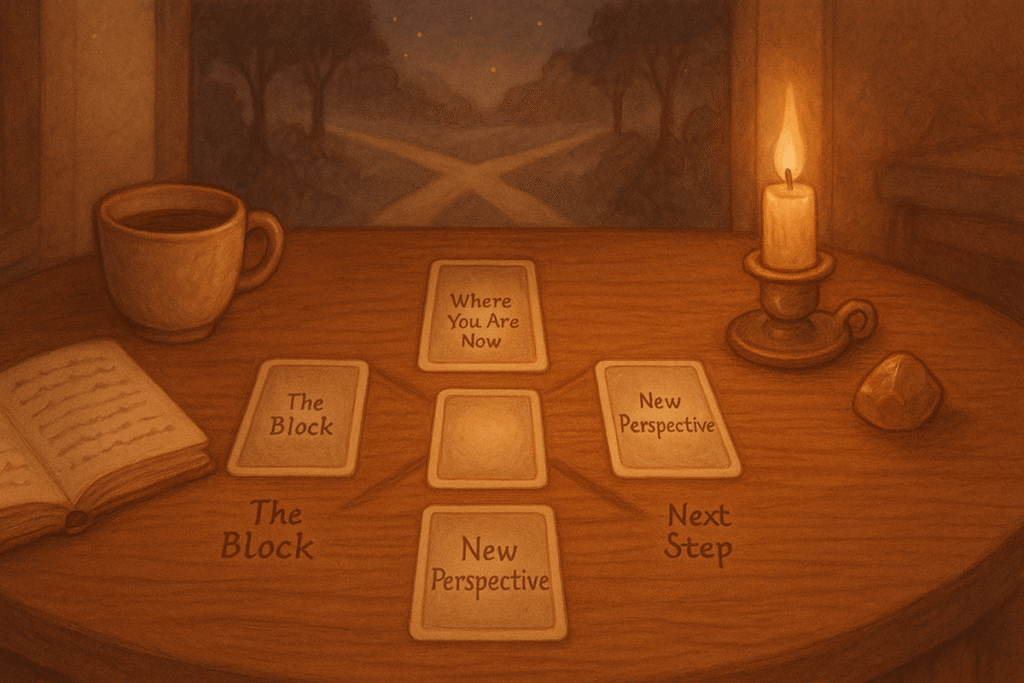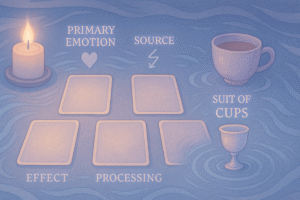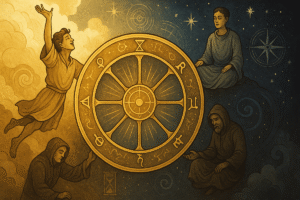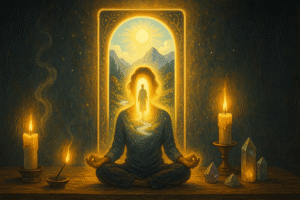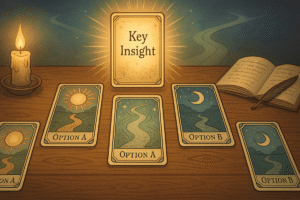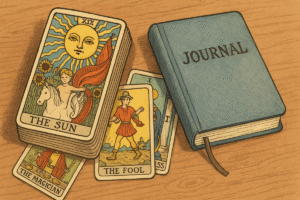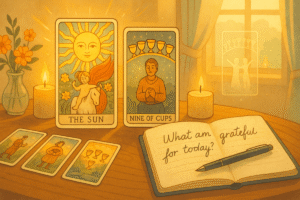Table of Contents
Sometimes life just stops making sense. You wake up, go through the motions, and still can’t figure out why everything feels so heavy. Not in a dramatic way, necessarily. Just stuck. Like you’re walking through fog without a clear destination, and no matter how hard you think about it, the path forward remains unclear.
I’ve found that these moments of general confusion are actually some of the most valuable times to sit with tarot cards. Not because the cards will tell you what to do (they won’t), but because they create a structure for asking yourself better questions. This particular tarot spread for feeling stuck is designed for exactly these moments when you can’t quite put your finger on what’s wrong, but you know something needs to shift.
Understanding This Type of Stuckness
The feeling I’m talking about isn’t about a specific decision. It’s not “should I take this job” or “should I move to a new city.” Those are concrete questions with actual choices attached. This is different. It’s more ambient, more pervasive. You might describe it as restlessness, or maybe a sense that you’re treading water while everyone else seems to be swimming somewhere purposeful.
Perhaps you’ve been feeling this way for weeks, or maybe it just crept up on you last Tuesday. The timeline doesn’t really matter. What matters is that general confusion has a different texture than specific uncertainty. It requires a different approach.
Traditional tarot spreads often focus on particular situations or questions. They work wonderfully when you know what you’re asking. But when the confusion itself is the problem, when you can’t even articulate what’s bothering you, you need something that helps you explore the landscape of your current internal state rather than pointing toward a predetermined answer.
Why Reflection Works Better Than Prediction
Before we get into the actual spread, I think it’s worth talking about why this reflective approach is so much more useful than trying to predict your way out of feeling stuck. I used to approach tarot wanting answers, wanting the cards to just tell me what was going to happen or what I should do. And honestly, that never worked very well.
The thing about feeling stuck is that it’s rarely about lacking information. It’s usually about not seeing the information you already have clearly enough. You probably already know, somewhere inside, what needs attention. The challenge is accessing that knowledge and trusting it.
When you use tarot as a mirror instead of a crystal ball, something interesting happens. You stop waiting for external validation and start having a conversation with yourself. Each card becomes a prompt, a gentle nudge toward examining something you might have been avoiding or overlooking. The imagery, the symbolism, the traditional meanings… they all just serve as catalysts for your own insight.
This is particularly important when you’re dealing with general confusion rather than a specific problem. There’s no single right answer to uncover because the real work is in understanding the question itself more deeply.
The Five Card Clarity Spread
This spread uses five positions, each designed to illuminate a different aspect of your current stuckness. I’ve organized it in a way that moves from understanding your present state, through identifying obstacles and resources, and finally toward actionable steps. Not because action is always necessary, but because sometimes having one small thing to try can break the paralysis.
The layout itself is simple. You can arrange the cards in a line, or in whatever configuration feels right to you. I usually lay them out left to right, but I’ve also seen people arrange them in a cross pattern or even a circle. The physical arrangement matters less than your intention and attention as you work with each position.
Position One: Where You Are Now
The first card asks you to look honestly at your current state. What does this moment actually feel like? Not what you think it should feel like, or what you wish it felt like, but what’s actually true for you right now.
When you draw this card, sit with it for a moment. What emotions does the imagery bring up? Does it feel accurate, or does it feel wrong? Sometimes a card that feels “wrong” is actually showing you something you’ve been denying. Other times it really is just not resonating, and that’s okay too.
Consider these questions as you reflect on this position. What has your energy been like lately? When do you feel most like yourself, and when do you feel most disconnected? Are there patterns in when the stuck feeling intensifies or eases?
This position isn’t about judgment. It’s not about whether where you are is good or bad. It’s simply about recognition. You can’t navigate your way forward if you won’t acknowledge where you’re starting from. Sometimes just naming your current state honestly is enough to create a tiny shift in perspective.
Position Two: The Nature of the Block
The second position gets at what’s actually creating the stuck feeling. This can be trickier to interpret because blocks aren’t always obvious. Sometimes what we think is blocking us is actually a symptom of a deeper issue.
I find it helpful to think about blocks in categories, though not rigidly. Sometimes the block is external… circumstances genuinely outside your control that are limiting your options. Other times it’s internal, like a belief system or fear that’s keeping you frozen. Often it’s a combination.
When you look at this card, ask yourself what it suggests about the nature of your particular block right now. Is it about fear of making the wrong choice? Is it about not having enough information, or having too much conflicting information? Is it about energy, about being depleted in some way that makes forward movement feel impossible?
Pay attention to whether the card shows active resistance or passive stagnation. There’s a difference between being blocked by something and choosing, perhaps unconsciously, to stay put because movement feels too risky or too demanding.
Position Three: A Resource You Are Overlooking
This is often my favorite position in the spread because it tends to surprise people. We’re usually so focused on what we lack, what’s wrong, what’s missing, that we completely miss the resources right in front of us.
The resource could be anything. It might be a skill you have but aren’t applying to this situation. It might be a person in your life who could offer support if you asked. It might be a perspective you used to hold but have somehow abandoned. It could even be something as simple as rest, or patience, or humor.
When you draw this card, try to think beyond the obvious. If you pull a card traditionally associated with relationships, it doesn’t necessarily mean you need to call a friend. It might mean you need to reconsider how you’re relating to yourself, or to the situation. If you draw a card associated with action, maybe the overlooked resource isn’t doing more, but recognizing that you have the capability to act even if you’re choosing not to right now.
What do you already have access to that you’ve forgotten about or dismissed as irrelevant? What worked for you in past situations that felt similarly confusing? Sometimes the resource is as simple as remembering that you’ve felt stuck before and found your way through.
Position Four: A Helpful Perspective to Adopt
Perspective shifts can be remarkably powerful, even when nothing in your external circumstances changes. This position asks what way of looking at your situation might be more useful than how you’ve been viewing it.
I think perspective is underrated as a tool for getting unstuck. We tend to believe our initial interpretation of events is objective reality, but it never is. There are always multiple ways to understand what’s happening. Some of those ways will keep you stuck, and others will open up possibilities.
When you look at this card, consider what it might be suggesting about how to reframe your situation. If the card shows conflict, maybe the helpful perspective is recognizing that tension isn’t always destructive. Sometimes it’s generative. If the card shows stillness, maybe the perspective shift is about seeing this stuck period as necessary rather than as a problem to fix immediately.
What would change if you looked at your confusion not as a failure but as information? What if feeling stuck is actually your psyche’s way of protecting you from rushing into something before you’re ready? These kinds of perspective shifts don’t solve anything directly, but they can change your relationship to the problem in ways that make solutions more accessible.
Position Five: The Immediate Next Small Step to Take
The final position offers something concrete, but notice that it asks for a small step, not a grand solution. When you’re feeling generally confused and stuck, big dramatic actions are rarely helpful. They’re often just another form of avoidance, a way to feel like you’re doing something without actually addressing the underlying issue.
A small step might be something like starting a daily journaling practice, or taking a walk in a different neighborhood, or having a conversation you’ve been postponing. It might be researching something that interests you, or clearing out a drawer, or trying a new creative practice.
The point of this position isn’t to solve your stuck feeling entirely. It’s to give you one specific, manageable action that connects to the insights from the previous four cards. Movement, even tiny movement, can break the sense of paralysis that often accompanies confusion.
When you interpret this card, be realistic about what “small” means. If the card suggests something that feels overwhelming, scale it down. The goal is to create momentum, not to add another burden to your list of things you should be doing but aren’t.
Working With Your Reading
After you’ve drawn all five cards and spent time with each position, I recommend taking a few moments to look at the spread as a whole. Do you notice any patterns? Are there recurring themes or elements across multiple cards? Sometimes the overall message emerges not from individual cards but from how they relate to each other.
It can be helpful to journal about your reading, not in a structured way but just stream of consciousness writing about what came up for you. What surprised you? What confirmed something you already suspected? What still feels unclear?
You might also consider coming back to the reading after a day or two. I’ve found that initial interpretations often shift once you’ve had time to sit with the cards. Something that seemed irrelevant might suddenly feel significant, or vice versa.
Remember that this spread isn’t about getting everything right immediately. It’s a tool for reflection, not a test you can pass or fail. If something doesn’t resonate, let it go. If something sparks recognition, follow that thread and see where it leads.
The goal here is simply to create a little more clarity, a little more breathing room in the fog of confusion. You’re not looking for all the answers. You’re just looking for the next right question, or the next small insight, or the next manageable step. That’s enough.
Frequently Asked Questions
Can I use this spread multiple times for the same stuck feeling?
It’s best to give yourself at least a few weeks between readings on the same general confusion. If you read too frequently, you won’t have time to act on the insights or let your situation naturally evolve, which means the cards will likely show you the same message. Use the spread once, work with what it reveals, and only return to it if your circumstances have genuinely shifted or enough time has passed for new patterns to emerge.
What if the cards don’t seem to make sense or feel wrong?
Sometimes cards that feel “wrong” are actually showing you something you’ve been avoiding or denying. Sit with the discomfort for a day or two before dismissing the reading. However, if a card truly doesn’t resonate after reflection, trust that too. Not every reading will be perfectly clear, and that’s okay. You might try the spread again when you’re in a calmer mental state, or simply take what does resonate and leave the rest.
Do I need to interpret all five cards together or can I focus on just one position?
Both approaches work. You can absolutely focus on whichever position feels most urgent or relevant to you right now. Maybe position two (the block) is what you need to understand most, so spend your energy there. However, looking at how the cards relate to each other often reveals patterns or connections you might miss when reading them individually. There’s no wrong way to work with the spread as long as it’s helping you gain clarity.
How do I know if I should take action based on position five or just keep reflecting?
Position five suggests a small step, not a complete solution. If the action feels manageable and aligned with the other insights from your reading, try it. If it feels overwhelming or forced, scale it down even further or simply hold it as a possibility while you continue reflecting. The goal isn’t to fix everything immediately but to create tiny momentum. Sometimes the most helpful “action” is simply paying attention differently or asking yourself better questions.

